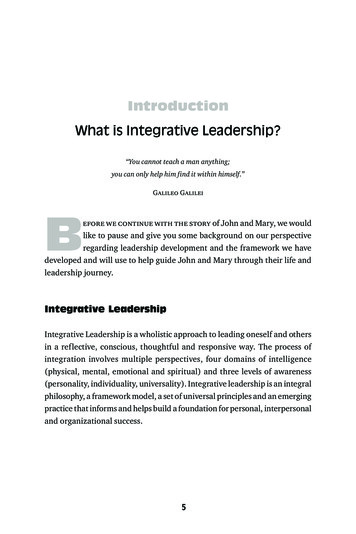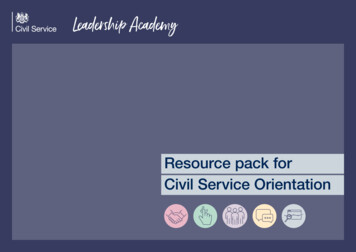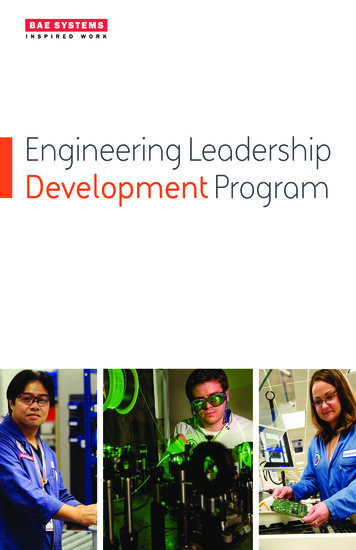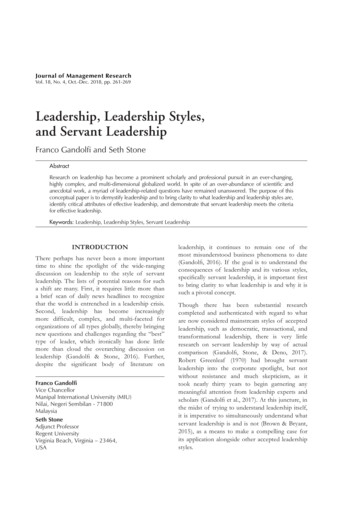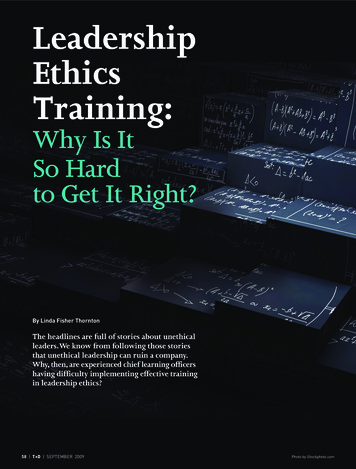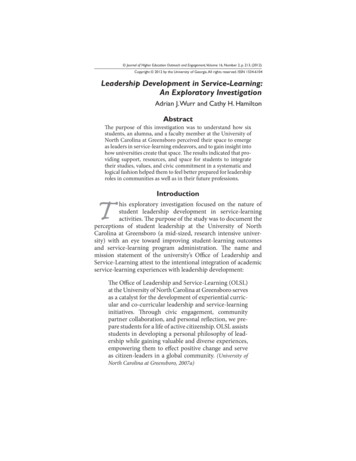
Transcription
Journal of Higher Education Outreach and Engagement,Volume 16, Number 2, p. 213, (2012)Copyright 2012 by the University of Georgia. All rights reserved. ISSN 1534-6104Leadership Development in Service-Learning:An Exploratory InvestigationAdrian J. Wurr and Cathy H. HamiltonAbstractThe purpose of this investigation was to understand how sixstudents, an alumna, and a faculty member at the University ofNorth Carolina at Greensboro perceived their space to emergeas leaders in service-learning endeavors, and to gain insight intohow universities create that space. The results indicated that providing support, resources, and space for students to integratetheir studies, values, and civic commitment in a systematic andlogical fashion helped them to feel better prepared for leadershiproles in communities as well as in their future professions.TIntroductionhis exploratory investigation focused on the nature ofstudent leadership development in service-learningactivities. The purpose of the study was to document theperceptions of student leadership at the University of NorthCarolina at Greensboro (a mid-sized, research intensive university) with an eye toward improving student-learning outcomesand service-learning program administration. The name andmission statement of the university’s Office of Leadership andService-Learning attest to the intentional integration of academicservice-learning experiences with leadership development:The Office of Leadership and Service-Learning (OLSL)at the University of North Carolina at Greensboro servesas a catalyst for the development of experiential curricular and co-curricular leadership and service-learninginitiatives. Through civic engagement, communitypartner collaboration, and personal reflection, we prepare students for a life of active citizenship. OLSL assistsstudents in developing a personal philosophy of leadership while gaining valuable and diverse experiences,empowering them to effect positive change and serveas citizen-leaders in a global community. (University ofNorth Carolina at Greensboro, 2007a)
214 Journal of Higher Education Outreach and EngagementLeadership positions in student organizations and university governance committees, both co-curricular initiatives, aretraditionally seen as providing formative experiences for individuals interested in developing their leadership skills. The presentinvestigation was designed to explore whether participation inthoughtfully organized service-learning experiences might alsoprovide fertile ground for leadership formation, and if so, in whatways.Leadership and service-learning programs and policies arealso designed to provide students with multiple pathways tobecome engaged leaders. The University of North Carolina atGreensboro cultivates leadership courses across campus and offersthe Leadership Challenge Program, a co-curricular programfor students interested in learning more about personal leadership development. Courses that enhance the eight competenciesof the University of North Carolina at Greensboro LeadershipFramework (self-awareness/self-management, relationship/groupdevelopment, task management, creative visioning and problemsolving, effective communication, valuing diversity, communityengagement, and ethical decision making) and that students in theLeadership Challenge Program are encouraged but not required totake are noted on lists for students and advisors (University of NorthCarolina at Greensboro, 2007b). Similarly, all service-learning coursesare designated with an “SVL” attribute in the schedule of classes,and must meet criteria for best practices, including linking coursecontent with meaningful service and reflection (University of NorthCarolina at Greensboro, 2007c).Rationale for Student Leadership DevelopmentTwo trends speak to the urgency of higher education’s need tofoster leadership more effectively. The first trend is found in therealm of career preparation. Results from Association of AmericanColleges and Universities’ National Leadership Council for LiberalEducation and America’s Promise (LEAP) surveys indicate that of305 employers interviewed, 63% believe college graduates lackedthe skills needed for a global economy and for promotion (Kuh,2008). Moreover, as baby boomers retire, communities are facedwith marked gaps in nonprofit leadership (Tierney, 2006), a trendmirrored in the corporate world as well (Druker, 1998; Lombardo &Euchinger, 2000 as cited in Yarborough, 2011).A second trend that speaks to the need for student leadership development stems from an awareness that today’s citizenry
Leadership Development in Service-Learning: An Exploratory Investigation 215needs skills to confront the challenges of a rapidly changing,knowledge-based, global economy and environment. Complexsocietal issues require interdisciplinary approaches to addressthem. UNC Tomorrow, a commissioned report in 2007 by theUniversity of North Carolina System, focused on a mandate forpublic institutions to become proactive in response to quality oflife and economic needs of the state and region (UNC TomorrowCommission, 2007). To address the trend, a growing number of civicand academic leaders are calling on universities to nurture futureleaders (Yarborough, 2011). In Leadership Reconsidered, Astin andAstin (2000) posit that “an important ‘leadership development’challenge for higher education is to empower students, by helpingthem develop those special talents and attitudes that will enablethem to become effective social change agents” (p. 2).Literature Review: Student LeadershipDevelopmentPrior research suggests that involvement in leadership opportunities during the college years has positive impacts on students:It enhances conflict resolution and commitment to civic responsibility, inspires a greater sense of efficacy in shaping the worldaround them, and enables active learning through collaborationand improved social adjustment (Cress, Astin, Zimmerman-Oster, &Burkhardt, 2001; Tomlinson-Clarke & Clarke, 1994). Creating spacefor students to develop leadership skills within service-learningcourses not only helps students implement university-communityprojects, but also provides substantive opportunities for the students to shape the nature of the service-learning project (Chesler,Kellman-Fritz, & Knife-Gould, 2003). Thus, service-learning projectsare uniquely positioned to foster leadership skills because theyencourage students to become co-producers of knowledge.It is interesting to note that although service-learning hasgained widespread acceptance in higher education as a facultyled initiative, the movement began with grassroots organizing bystudents and community activists in the 1960s (Zlotkowski, Longo,& Williams, 2006). Considering this history, the editors and contributing authors for Students as Colleagues (Zlotkowski et al., 2006)argue that service-learning must find new ways to inspire studentleadership in the future if the movement is to continue to grow.“Just as the service movement once needed resources that studentsalone could not contribute, so the movement has now reached apoint where it needs the resources that students alone can supply”(Zlotkowski et al., 2006, p. 3).
216 Journal of Higher Education Outreach and EngagementA growing number of studies point to the efficacy of promoting leadership development through service-learning projects.The convergence of data from both student leadership development studies (Astin, 1993; Astin & Astin, 2000; Astin & Cress, 1998;Dugan, 2006a, 2006b; Dugan & Komives, 2007; Kirlin, 2003; Komives,Owen, Longerbeam, Mainella, & Osteen, 2005; Komives, Longeream,Owen, Mainella, & Osteen, 2006; Kouzes & Posner, 2003) and servicelearning research (Astin & Astin, 2000; Eyler & Giles, 1999; Eyler, Giles,& Braxton, 1997; Kuh, 2008; Moely, McFarland, Miron, Mercer, & Ilustre,2002; Pascarella & Terenzini, 2005) not only supports the claim thatleadership skills can be taught, but also that leadership programspositively affect a wide range of personal and social learningoutcomes, including personal efficacy and interpersonal communication skills.Even the most current and widely acclaimed evidence-basedresearch on student leadership development, however, drawsalmost exclusively on co-curricular experiences such as residencelife, Greek life, student government, and student organizations(Kouzes & Posner, 2008). The authors believe that intentional leadership development within course-based service-learning projectsremains underutilized by faculty members.One reason for this, Des Marais, Yang, and Farzanehkia (2000)suggest, is the traditional views of leadership held by some facultymembers. Drawing on Burns’ (1978) distinction between transactional and transformational leadership models, the authors suggestthat too many faculty members subscribe to traditional “transactional” leadership models, which emphasize leader-centric viewsof leadership (e.g., leadership is vested in a position or a singleleader), rather than more complex leadership models (Chrislip &Larson, 1994; Kouzes & Posner, 2003) that favor collaborative, valuescentered transformational approaches.[M]ost often, students are assigned to do a particulartask rather than being allowed to determine eachand every step of a service-learning experience, fromcommunity assessment, to evaluation, to celebration.Simply assigning students tasks in teacher-designedservice-learning projects denies them the opportunityfor decision making and action planning. It limits theirunderstanding of the interconnectedness of tasks andgives them no sense of the complexity of project management and leadership. (Des Marais et al., 2000, p. 679)
Leadership Development in Service-Learning: An Exploratory Investigation 217Writing as student authors and leaders, Des Marais et al.(2000) argue persuasively that students are capable of engaging intransformational service-learning projects where decision-makingand responsibilities are shared among all participants. Studentsas Colleagues (Zlotkowski et al., 2006) recognizes this potential bydescribing ways to identify, recruit, and train student leaders inservice-learning projects. With 24 chapters edited or authored bystudent-faculty teams, Students as Colleagues describes best practices for service-learning leadership development. Reading theseworks, the authors of the present investigation were convinced thatstudents could play an instrumental role in the national servicelearning movement if, and when, their professors provided themwith the resources and space to emerge as leaders.The investigation presented in this article was also informed byleadership identity development theory (Komives et al. 2005; Komiveset al. 2006), which was used to frame the study’s findings, and Duganand Komives’ (2007) Multi-Institutional Study of Leadership, whichwas used to support the discussion and implications of findings.In 2006, the Multi-Institutional Study of Leadership surveyedover 50,000 college students from 52 campuses nationwide abouttheir experiences as students and leaders. The findings led Duganand Komives to offer 10 recommendations to enrich campusleadership programs. The Multi-Institutional Study of Leadershiprecommendations are explored in relation to the present investigation’s findings in the Discussion section. Although service-learningis not explicitly mentioned as a component of programs considered in the survey, the authors of the present investigation believeservice-learning provides an effective framework for the majorityof practices that Dugan and Komives recommend.Assessing Leadership Development inService-Learning Projects at the University ofNorth Carolina at GreensboroThe authors share an interest in service-learning researchfocused on enhancing student learning and development. At thetime of the study, the lead author was a full-time English facultymember who also served as a service-learning faculty fellow forthe university; the other author serves as University of NorthCarolina at Greensboro director of the Office of Leadership andService-Learning, the office that has worked to institutionalizeservice-learning as well as provide faculty development for engagedteaching, learning, and research. Wurr now directs the servicelearning program at the University of Idaho. The purpose of this
218 Journal of Higher Education Outreach and Engagementinvestigation was (1) to understand how students at the Universityof North Carolina at Greensboro perceive their space to emergeas leaders in service-learning activities and (2) to gain insight intohow universities create that space. Grounded theory was selected asthe method for the investigation. The goal was to generate a schemaof a phenomenon “grounded” in the experience and perceptions ofthe participants (Brown, Stevens, Troiano, & Schneider, 2002; Creswell,1998; Strauss & Corbin, 1998).The SampleInstitutional Review Board (IRB) human subjects approval wassecured for the study. The sample was determined using “intensitysampling” that included “information-rich cases that manifest thephenomenon intensely, but not extremely” (Patton, 2002, p. 243) representing three groups: (1) current (2006) student leaders in fallsemester service-learning projects, (2) former student leaders in aservice-learning project, and (3) faculty members who taught andsupported service-learning classes. As an exploratory investigation,the research design did not include control groups. The objectivewas to learn as much as possible from good examples of leaderson campus.In 2005, faculty members teaching service-learning courseswere asked to submit names of students exhibiting leadershipskills in their service-learning classes. Selection of six student participants was based on the demonstrated leadership abilities andinterests of the students as identified by their professors. The faculty members teaching service-learning also provided names ofrecent graduates from their classes who had exhibited leadership.Only one student responded to an interview request. One facultymember also participated. She was a faculty fellow for the Officeof Leadership and Service-Learning. The office’s service-learningfaculty fellow program, which promotes faculty leadership andadvocacy for service-learning, is a 1-year program offered to experienced service-learning faculty members who work with the officeto advance institutional change to increase understanding of andreward for service-learning and community service endeavors.3URÀOH RI WKH SDUWLFLSDQWV Of the six student participants, two were African Americanmen (one graduate and one undergraduate), two were undergraduate African American women, and two were Caucasian women(one graduate and one undergraduate). The alumna representative
Leadership Development in Service-Learning: An Exploratory Investigation 219was a Caucasian woman, as was the faculty member. The sampleprofile reflected the diversity of the University of North Carolina atGreensboro student population, though African American studentsrepresented a greater proportion of participants (50%) than they doin the overall student population at University of North Carolina, atGreensboro. At the time of the study, the total University of NorthCarolina at Greensboro student population was 15,920, including12,689 undergraduates and 3,231 graduate students. Of the undergraduate population, 68% were female and 20% African-American.Seventy-eight percent of undergraduate African-Americans werefemale. Fourteen percent of the graduate student population wasAfrican-American and 81% of those were female.Data CollectionThe eight participants engaged in semi-structured interviewslasting about an hour each. The interview questions were openended and focused on the personal and institutional qualities thatenhanced or hindered the participants’ growth as leaders. Theinterviews were audio recorded and transcribed.'DWD DQDO\VLV The data were analyzed using constant comparative analysis(Patton, 2002; Strauss & Corbin, 1998) to identify themes and sub-themes. As shown in Table 1, items were coded independently bythe authors and then organized into generative themes, recurringthreads of thought that document a pervasive sentiment expressedby the majority of participants in a study (Freire, 1970, p. 97; Marshall& Rossman, 1999, pp. 152–153; Miles & Huberman, 1994, p. 131; Patton,2002, pp. 475–477).7DEOH &RGLQJ 6WUHQJWK DQG ,QWHU 5DWHU 5HOLDELOLW\ ,55CategorySameDifferent orMissedIRRLeadership Identity Formation42783%Provided Space361266%Part of Something Larger34488%The FindingsThree themes emerged from 112 data items: (1) “leadershipidentity formation,” in which the participants described how theycame to think and act like leaders; (2) “provided space”—the
220 Journal of Higher Education Outreach and Engagementinstitutional structures, pedagogical practices, and curricular orco-curricular activities that provided participants with the spaceneeded to realize their full potential as leaders; and (3) “part ofsomething larger,” which focused on the participants’ socialidentity, including personal and civic agency development. In thesections that follow, each category is described further.The authors will report the findings of the data related to thetheme “leadership identity formation” using the leadership identity development model described by Komives et al. (2005). Thesix-stage process of leadership identity development they describewas a useful framework to structure reporting the findings ofthe data. This model identifies six sequential stages of leadershipdevelopment.Stage 1. Awareness: Recognizing that leadership is happeningaround youStage 2. Exploration/engagement: Intentional involvements ingroups and meaningful experiences; taking onresponsibilitiesStage 3. Leader identified: Trying on new roles and responsibilities; managing othersStage 4. Leadership differentiated: Awareness that leadershipcan be non-positional—that leadership is a groupprocessStage 5. Generativity: Accepting the responsibility for thedevelopment of others and for sustaining organizationsStage 6. Integration/synthesis: Continued self-developmentand lifelong learning; striving for congruence andinternal confidence (Komives et al., 2005, pp. 606–607)Each stage of leadership identity development ends with a transition signaling leaving one stage and beginning the next. In this way,the stages describe an individual developmental process heavilyinfluenced by group interactions.Leadership Identity FormationAbout a third of the comments coded by the authors fell intothe “leadership identity formation” category. Of these, none wascoded as Stage 1 or 2 of the leadership identity development model;10 were coded as Stage 3, 16 as Stage 4, 14 as Stage 5, and twoas Stage 6. Representative statements classified by correspondingstage include
Leadership Development in Service-Learning: An Exploratory Investigation 221t Stage 3 (leader identified): “I was in student government all through high school, and I have always been. . . a natural leader.”t Stage 4 (leadership differentiated): “I really wasn’taware that leadership wasn’t just about one person. Ithink that is the main thing I got out of the [servicelearning] class.”t Stage 5 (generativity): “Being a leader is just knowingthat being the person you are makes a difference, justbeing aware of your actions.”t Stage 6 (integration/synthesis): “I think some peoplehave a one-or-two sentence definition of leadership,and they just kind of put the pen down and everything fits in that box. But it’s so much more than twosentences: It’s life! I think that’s one of the things I’velearned—your whole life can be leading people andserving them; it’s not just a departmental opportunityor [something you do] one Saturday morning.”Provided SpaceThe data that were categorized as “provided space” referencedcurricular and co-curricular structures or classroom initiativeswhich reflect the democratic spaces described by Zlotkowski,Longo, and Williams (2006) whereby students “develop, use, andown their voices on a host of public issues” (p. 7). In the case of ourstudy, the students’ recognition of these democratic spaces supportsthe process of leadership development. These included commentson course and assignment requirements, and the development ofpersonal networks and relationships that built student interpersonal efficacy and self-confidence working in and leading groups.Thus, the concept of providing space is roughly equivalent to thatof liberty and the antithesis of micromanagement. Commentsindicated whether the initial motivation for students to adoptleadership roles was curricular or co-curricular, and whether theparticipants were “chosen” to be leaders (i.e., positional leadership)or leadership emerged from within (“emergent”). Representativecomments for each category are below.t Curricular, chosen: “Our main project for the class iseach graduate student was assigned a group of undergraduate students to lead in a service-learning project.”
222 Journal of Higher Education Outreach and Engagementt Curricular, emergent: “I think that is why everyoneneeds service-learning because you learn that leadership is not just about one person. . . . It’s abouteveryone. You know everyone makes things happen.”t Co-Curricular, chosen: “The staff don’t necessarilywant to make you feel as if you’re the student andthey’re the older adult. . . . They are constantly engagingyou in what they’re doing. . . . They’re not lecturing;they’re engaging you in dialogue. I think that reallyshows a respect they have for you as an adult and as afellow participant in leadership and service-learning.”t Co-Curricular, emergent: “I think that’s why peoplekeep coming back to leadership and service-learningand why students love participating in it because it’ssomething where you make it your own and whenyou walk away from it, it’s different for you than forthe other person, but you’re grateful for having doneit yourself.”Part of Something LargerThe respondents in this investigation reflected on theirmotivations for becoming involved in service-learning and leadership activities. Although the eight were inspired by the thought ofmaking a small contribution to the larger good of the community,some expressed these sentiments in relation to societal issues suchas racism, literacy, or poverty, while others focused on personalmotivations such as changes in beliefs, social agency, and careerchoices. For example, one student reported that “the servicelearning experience gave a whole broader view of what I could dobecause I was always business oriented and assumed I would goback into the corporate world. I have no desire to go back to thecorporate world. I would much rather deal in non-profits or as anadvocate.” Another student commented,I was in the Air Force for a while and I volunteered asa youth center at my base. There I saw a lot of underserved kids, their parents were away a lot, and the kidswere affected. So I became like a male mentor to thekids. I saw that I could have a huge effect on these kids.Like some of the ones that would never go to college,went. So I got out of the Air Force and started wantingto work with kids full time.
Leadership Development in Service-Learning: An Exploratory Investigation 223For another student, the motivation to become involved inservice-learning and leadership activities was personally motivatedby a commitment to social change; service-learning provided thisstudent with a clearer sense of purpose in life, as shown in the following quote:Since 1968 the poverty level has been the same as it istoday, nothing has changed, and that’s what I’m going todo. The FBI has a secret blacklist that they put activistson and I’m going to be on that list ’cause I’m going to saysomething that’s going to upset somebody in very manyways. First thing I’m stopping is gang violence, after thatit is poverty, and after that I’m going for something else.I’ve always been a very passionate person, but I can saythis class has definitely helped me focus in some wayswhere I have a lot clearer example of what I should be,I guess you could say.In several instances students noted shifting into advocacy roles,prompting the authors to consider advocacy as a separate category.Ultimately, however, it was decided that advocacy connected to“part of something larger,” and was a subset of leadership development as a process (Althaus, 1997).Leadership as a Process: A ConceptualFrameworkAs illustrated in Figure 1, a conceptual framework of leadership as a process indicates a relationship among the three themes.)LJXUH &RQFHSWXDO )UDPHZRUN /HDGHUVKLS DV 3URFHVV
224 Journal of Higher Education Outreach and EngagementThe overarching theme that emerged from the data was a viewof leadership as a process. This meta-narrative explains the relationships between the other themes and subthemes in the data.Leadership as identity formation is a central theme in this metanarrative and closely parallels the six stages of leadership identitydevelopment described by Komives et al. (2005).DiscussionTable 2 lists the three themes that emerged from the data,recommendations for improving student leadership development(Dugan & Komives, 2007), and the potential outcomes.7DEOH 7KH 6WXG\·V 7KUHH 7KHPHV 5HFRPPHQGDWLRQV IRU (QKDQFLQJ /HDGHUVKLS 'HYHORSPHQW DQG 3RWHQWLDO 2XWFRPHV3UHVHQW 6WXG\·V Findings(Leadership as aProcess)'XJDQ .RPLYHV· 5HFRPPHQGDWLRQV IRU (IIHFWLYH Leadership Development3RWHQWLDO 2XWFRPHVLeadershipIdentity Formation (QJDJH VWXGHQWV LQ FRQYHUVDWLRQVthat matter (sociocultural issues) (QFRXUDJH GHSWK RI LQYROYHPHQW YV breadth in group experiences )RVWHU PHQWRULQJ UHODWLRQVKLSV ZLWKfaculty and staff 6HUYLFH OHDUQLQJ FDQ SURYLGH VWXGHQWV ZLWKstructured opportunitiesto explore diversity &LYLF HQJDJHPHQW RIÀFHVcan serve as theadministrative hub forstudents to exploreleadership in increasinglycomplex contexts 6HUYLFH OHDUQLQJ DQG community-basedresearch can engagestudents and faculty inmeaningful relations and NQRZOHGJH SURGXFWLRQProvided Space 'LIIXVH OHDGHUVKLS SURJUDPV DFURVVthe institution 6HUYLFH OHDUQLQJ FDQ FURVVdisciplines and content /HDGHUVKLS GHYHORSPHQWcan be embedded inservice-learningPart of SomethingLarger (QKDQFH FDPSXV LQYROYHPHQW LQclubs (QFRXUDJH SDUWLFLSDWLRQ LQ leadership programs OLJQ VWXGHQWV· VHOI SHUFHSWLRQ RI OHDGHUVKLS FRQÀGHQFH DQGcompetence 6HUYLFH OHDUQLQJ FDQ provide alternate SDWKZD\V WR FDPSXV DQGcommunity engagement &ULWLFDO UHÁHFWLRQ RQcommunity engagementcan heightenunderstanding of self andsociety 6HUYLFH OHDUQLQJ DQGcommunity-basedresearch projects canpromote both skills and SHUFHSWLRQV RI HIÀFDF\
Leadership Development in Service-Learning: An Exploratory Investigation 225Leadership Identity FormationStages 3 and 4 in Komives et al.’s (2006) leadership identitydevelopment model are “leader identified” and “leadership differentiated,” respectively, and are most significant to the presentinvestigation’s conceptual framework of leadership as a processbecause they represent a paradigm shift from a transactional to atransformational concept of leadership (Burns, 1978; HERI, 1996).Komives et al. describe Stage 3 “leader identified” thinking as“leadership seen largely as positional roles held by self or others.Leaders do leadership” (2006, p. 405).In Stage 4, “leadership differentiated,” there is a “new beliefthat leadership can come from anywhere in the group” (Komives etal., 2006, p. 405). Although it is estimated that only 50–66% of theadult population ever advances to Stage 4 consciousness, the shift ismost likely to occur around the age of 20 (“Kegan’s Orders,” 1999). Theauthors conclude from the data analysis that Stage 4 can be facilitated by participation in service-learning leadership experiences.In later stages of leadership development, students begin to acceptmore responsibility for engaging and supporting others (Stage 5)and internalize their identity as leaders (Stage 6).It is important to note, however, that while the leadership identity development stages are linear, they are also recursive in thatStage 4 must precede Stage 5 but does not exclude occasional stepsback to Stage 2 as students try out new ideas and roles (Komiveset al., 2006, p. 404). Data from the present investigation presentnumerous examples of the same student expressing ideas consistent with adjacent leadership identity development levels. Forexample, the student in the following quote shifts from “we” to ”I,”a change in voice and perspective that is consistent with the shiftfrom “leadership differentiated,” with its focus on interdependencyand the collective responsibilities of the group, to “generativity”and thinking about personal commitments to developing othersand sustaining groups: “We were scared, you know; I really wantedto kind of motivate them and inspire them to push through thatand to really be a voice for change even in the face [of] such anobstacle.”Provided SpaceThe key element of “space,” whether curricular or co-curricular, is providing enough space for students to take ownership ofa project, assignment, or their responsibilities to themselves andothers. Des Marais et al. (2000) observe that “Simply assigning
226 Journal of Higher Education Outreach and Engagementstudents tasks in teacher-designed service-learning projects deniesthem the opportunity for decision making and action planning”(p. 679).Although the authors experienced some challenges codingcomments in the “provided space” category – differing mostoften on coding comments as either Leadership Development (astudent-learning outcome) or Provided Space (a structural andprogrammatic outcome) – the results indicate that the curricularversus co-curricular distinction is less important than the spacestudents have for shaping their own learning experiences. Space,whether curricular or c
The University of North Carolina at Greensboro cultivates leadership courses across campus and offers the Leadership Challenge Program, a co-curricular program for students interested in learning more about personal leader-ship development. Courses that enhance the eight competencies of the University of North Carolina at Greensboro Leadership

